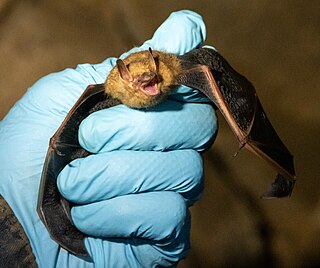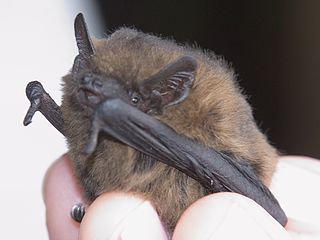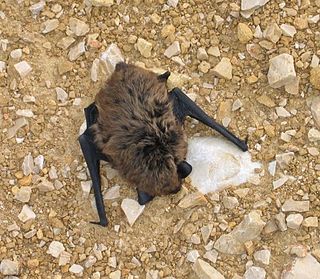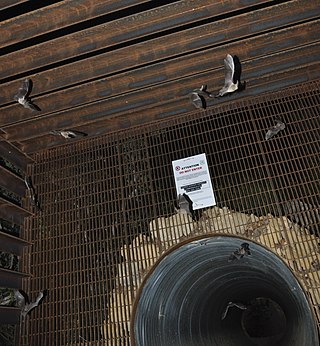
Pipistrellus is a genus of bats in the family Vespertilionidae and subfamily Vespertilioninae. The name of the genus is derived from the Italian word pipistrello, meaning "bat".

The tricolored bat is a species of microbat native to eastern North America. Formerly known as the eastern pipistrelle, based on the incorrect belief that it was closely related to European Pipistrellus species, the closest known relative of the tricolored bat is now recognized as the canyon bat. Its common name "tricolored bat" derives from the coloration of the hairs on its back, which have three distinct color bands. It is the smallest bat species in the eastern and midwestern US, with individuals weighing only 4.6–7.9 g (0.16–0.28 oz). This species mates in the fall before hibernation, though due to sperm storage, females do not become pregnant until the spring. Young are born helpless, though rapidly develop, flying and foraging for themselves by four weeks old. It has a relatively long lifespan, and can live nearly fifteen years.

The serotine bat, also known as the common serotine bat, big brown bat, or silky bat, is a fairly large Eurasian bat with quite large ears. It has a wingspan of around 37 cm (15 in) and often hunts in woodland. It sometimes roosts in buildings, hanging upside down, in small groups or individually. The name serotine is derived from the Latin serotinus, which means 'evening', while the generic name derives from Greek ἔπιεν and οίκος, which means 'house flyer'.

The common pipistrelle is a small pipistrelle microbat whose very large range extends across most of Europe, North Africa, South Asia, and may extend into Korea. It is one of the most common bat species in the British Isles. In Europe, the northernmost confirmed records are from southern Finland near 60°N.

The lesser horseshoe bat is a type of small European and North African insectivorous bat, related to its larger cousin, the greater horseshoe bat. As with all horseshoe bats, the species gets its name from its distinctive horseshoe-shaped noseleaf.

The soprano pipistrelle is a small species of bat. It is found in Europe and often roosts on buildings.

The lesser noctule, Leisler's bat or the Irish bat, is a species of insectivorous bat belonging to the vesper bat family, Vespertilionidae. The species was named to honour the naturalist Johann Philipp Achilles Leisler.

Savi's pipistrelle is a species of vesper bat found across North West Africa, the Mediterranean region and the Middle East. It feeds at night on flying insects. In the summer it roosts under bark, in holes in trees, in old buildings and in rock crevices but in winter it prefers roosts where the temperature is more even such as caves, underground vaults and deep rock cracks.

The common noctule is a species of insectivorous bat common throughout Europe, Asia, and North Africa.

The canyon bat, also known as the western pipistrelle, is a species of vesper bat. It is found in Mexico and in the western United States. The species has historically been placed in the genus Pipistrellus, but molecular evidence does not show any close relationship with that genus, and accordingly it was classified into its own genus, Parastrellus, in 2006.

Nyctophilus geoffroyi is a vespertilionid bat. a flying nocturnal mammal found in Australia, The species is relatively common. They have been referred to as the lesser long-eared bat.
The western false pipistrelle, species Falsistrellus mackenziei, is a vespertilionid bat that occurs in Southwest Australia. The population is declining due to loss of its habitat, old growth in tall eucalypt forest which has largely been clear felled for tree plantations, wheat cultivation and urbanisation. Although it is one of the largest Australian bats of the family, the species was not recorded or described until the early 1960s. A darkly colored bat with reddish brown fur and prominent ears, they fly rapidly around the upper canopy of trees in pursuit of flying insects.
The southern forest bat is a vesper bat found in Australia.
Bat detectors are the most common way to identify the species of flying bats. There are distinct types of call which can indicate the genus, and variations in pattern and frequency which indicate the species. For readers not familiar with the different types of bat detector, there is further information below and elsewhere.

The Christmas Island pipistrelle is an extinct species of vesper bat that was found only on Christmas Island, Australia.The last individual bat seen in August 2009 with no further sightings despite intensive efforts to locate it.

The long-fingered bat is a carnivorous species of vesper bat. It is native to coastal areas around the Mediterranean Sea, as well as a few patches of land in western Iran. Due to the fact that its population is in decline, it has been listed as Vulnerable on the IUCN Red List since 1988.

The Devon Bat Group (DBG) was founded in 1984 to help protect bats and their habitats, to look after injured bats and to advise and educate people about bats.

A maternity colony refers to a temporary association of reproductive female bats for giving birth to, nursing, and weaning their pups. The colonies are initiated by pregnant bats. After giving birth, the colony consists of the lactating females and their offspring. After weaning, juveniles will leave the maternity colony, and the colony itself will break apart. The size of a maternity colony is highly variable by species, with some species forming colonies consisting of ten or fewer individuals, while the largest maternity colony in the world in Bracken Cave is estimated to have over 15 million bats.
The Alashanian pipistrelle is a species of bat in the family Vespertilionidae. It is found in China, South Korea, Mongolia, Japan, and Russia.

Pipistrellini is a tribe of bats in the family Vespertilionidae. It contains several genera found throughout the Old World and Australasia, including the pipistrelles, noctules and related species.
















